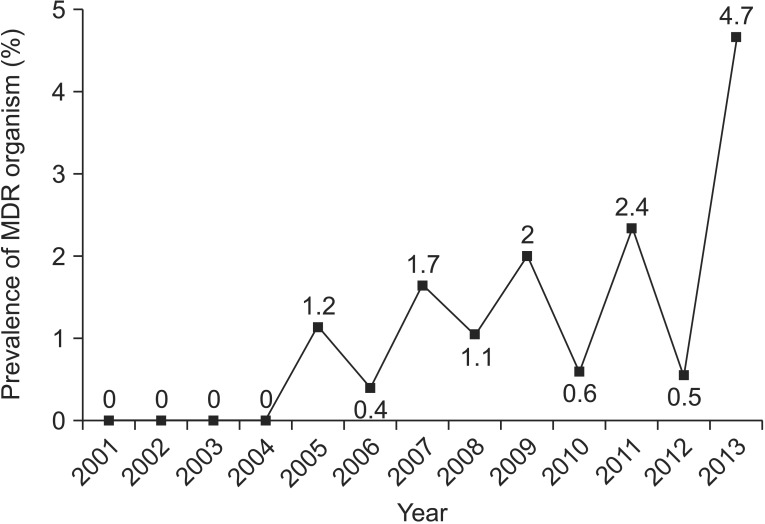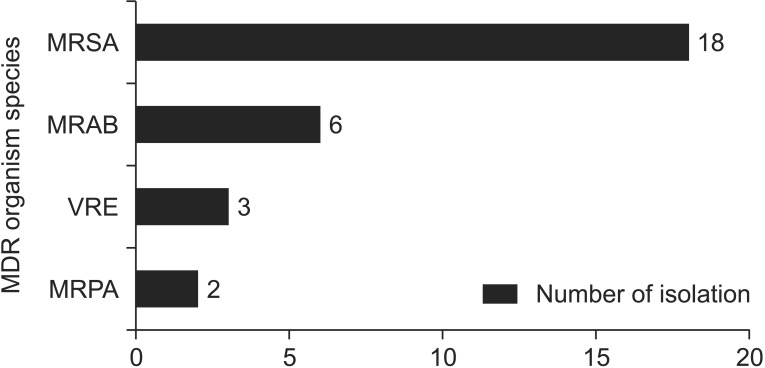Ann Rehabil Med.
2015 Oct;39(5):686-695. 10.5535/arm.2015.39.5.686.
Prevalence of and Risk Factors for Multidrug-Resistant Bacteria in Urine Cultures of Spinal Cord Injury Patients
- Affiliations
-
- 1Department of Physical Medicine and Rehabilitation, National Rehabilitation Center, Seoul, Korea. zeeahan@catholic.ac.kr
- KMID: 2148199
- DOI: http://doi.org/10.5535/arm.2015.39.5.686
Abstract
OBJECTIVE
To identify the prevalence of multidrug-resistant (MDR) bacteria and identify their specific risk factors in routine urine specimens of spinal cord injury (SCI) patients.
METHODS
This study was designed in a retrospective manner, reviewing the medical records of SCI patients who were admitted to a specialized SCI unit between January 2001 and December 2013. Patients were investigated for age, gender, American Spinal Injury Association impairment scale, SCI level, duration after injury, bladder management method, and hospitalization history within four weeks prior to visiting our unit. The results of routine urine cultures including presence of MDR organisms were analyzed.
RESULTS
Among the total 2,629 urine samples from the newly admitted SCI patients, significant bacteriuria was identified in 1,929 (73.4%), and MDR organisms were isolated in 29 (1.1%) cultures. There was an increasing trend of MDR organism prevalence from 2001 to 2013 (p<0.01). The isolation of MDR organisms in inpatients who were admitted for rehabilitation (1.3%) was significantly higher than it was among community-residing persons (0.2%) (p<0.05). By voiding method, patients who used a suprapubic indwelling catheter (3.3%) or a urethral indwelling catheter (2.6%) showed a higher rate of MDR organism isolation (p<0.05).
CONCLUSION
There was an increasing trend of MDR organism isolation in SCI patients. Inpatients and persons who used indwelling catheters showed a higher risk of MDR organism isolation.
MeSH Terms
Figure
Cited by 1 articles
-
Should We Delay Urodynamic Study When Patients With Spinal Cord Injury Have Asymptomatic Pyuria?
EunYoung Kim, Hye Jin Lee, Onyoo Kim, In Suk Park, Bum-Suk Lee
Ann Rehabil Med. 2021;45(3):178-185. doi: 10.5535/arm.20241.
Reference
-
1. Ginsberg D. The epidemiology and pathophysiology of neurogenic bladder. Am J Manag Care. 2013; 19(10 Suppl):s191–s196. PMID: 24495240.2. Pannek J. Treatment of urinary tract infection in persons with spinal cord injury: guidelines, evidence, and clinical practice. A questionnaire-based survey and review of the literature. J Spinal Cord Med. 2011; 34:11–15. PMID: 21528621.3. Cameron AP, Wallner LP, Tate DG, Sarma AV, Rodriguez GM, Clemens JQ. Bladder management after spinal cord injury in the United States 1972 to 2005. J Urol. 2010; 184:213–217. PMID: 20478597.
Article4. Fonte N. Urological care of the spinal cord-injured patient. J Wound Ostomy Continence Nurs. 2008; 35:323–331. PMID: 18496090.
Article5. Archibald L, Phillips L, Monnet D, McGowan JE Jr, Tenover F, Gaynes R. Antimicrobial resistance in isolates from inpatients and outpatients in the United States: increasing importance of the intensive care unit. Clin Infect Dis. 1997; 24:211–215. PMID: 9114149.
Article6. Hinkel A, Finke W, Botel U, Gatermann SG, Pannek J. Increasing resistance against antibiotics in bacteria isolated from the lower urinary tract of an outpatient population of spinal cord injury patients. Urol Int. 2004; 73:143–148. PMID: 15331899.
Article7. Faarvang KL, Muller P, Lomberg B, Biering-Sorensen F. Screening for bacteriuria in patients with spinal cord lesion: dipstick test, microscopic examination and urine culture. Spinal Cord. 2000; 38:106–108. PMID: 10762184.
Article8. Garcia Leoni ME, Esclarin De Ruz A. Management of urinary tract infection in patients with spinal cord injuries. Clin Microbiol Infect. 2003; 9:780–785. PMID: 14616697.9. Menon EB, Tan ES. Urinary tract infection in acute spinal cord injury. Singapore Med J. 1992; 33:359–361. PMID: 1411664.10. Waites KB, Chen Y, DeVivo MJ, Canupp KC, Moser SA. Antimicrobial resistance in gram-negative bacteria isolated from the urinary tract in community-residing persons with spinal cord injury. Arch Phys Med Rehabil. 2000; 81:764–769. PMID: 10857521.
Article11. Montgomerie JZ. Infections in patients with spinal cord injuries. Clin Infect Dis. 1997; 25:1285–1290. PMID: 9431366.
Article12. Waites KB, Canupp KC, Brookings ES, DeVivo MJ. Effect of oral ciprofloxacin on bacterial flora of perineum, urethra, and lower urinary tract in men with spinal cord injury. J Spinal Cord Med. 1999; 22:192–198. PMID: 10685384.
Article13. Ryu KH, Kim YB, Yang SO, Lee JK, Jung TY. Results of urine culture and antimicrobial sensitivity tests according to the voiding method over 10 years in patients with spinal cord injury. Korean J Urol. 2011; 52:345–349. PMID: 21687395.
Article14. Dedeic-Ljubovic A, Hukic M. Catheter-related urinary tract infection in patients suffering from spinal cord injuries. Bosn J Basic Med Sci. 2009; 9:2–9. PMID: 19284388.15. Shin JC, Yoo JH, Park JW, Park S, Ahn SJ, Park CI. Difference of organism and their antibiotics sensitivity from urine culture in symptomatic urinary tract infection of spinal cord injury patients. J Korean Acad Rehabil Med. 2008; 32:38–44.16. Darouiche RO, Priebe M, Clarridge JE. Limited vs full microbiological investigation for the management of symptomatic polymicrobial urinary tract infection in adult spinal cord-injured patients. Spinal Cord. 1997; 35:534–539. PMID: 9267920.
Article
- Full Text Links
- Actions
-
Cited
- CITED
-
- Close
- Share
- Similar articles
-
- Multidrug-Resistant Gram-Positive Bacterial Infections
- Multidrug-resistant bacteria: a national challenge requiring urgent addressal
- Risk Factors of Bladder Stone Formation in Spinal Cord Injuries
- A Study on the Incidence of Gallstones in Patients with Spinal Cord Injury
- Difference of Organism and Their Antibiotics Sensitivity from Urine Culture in Symptomatic Urinary Tract Infection of Spinal Cord Injury Patients



